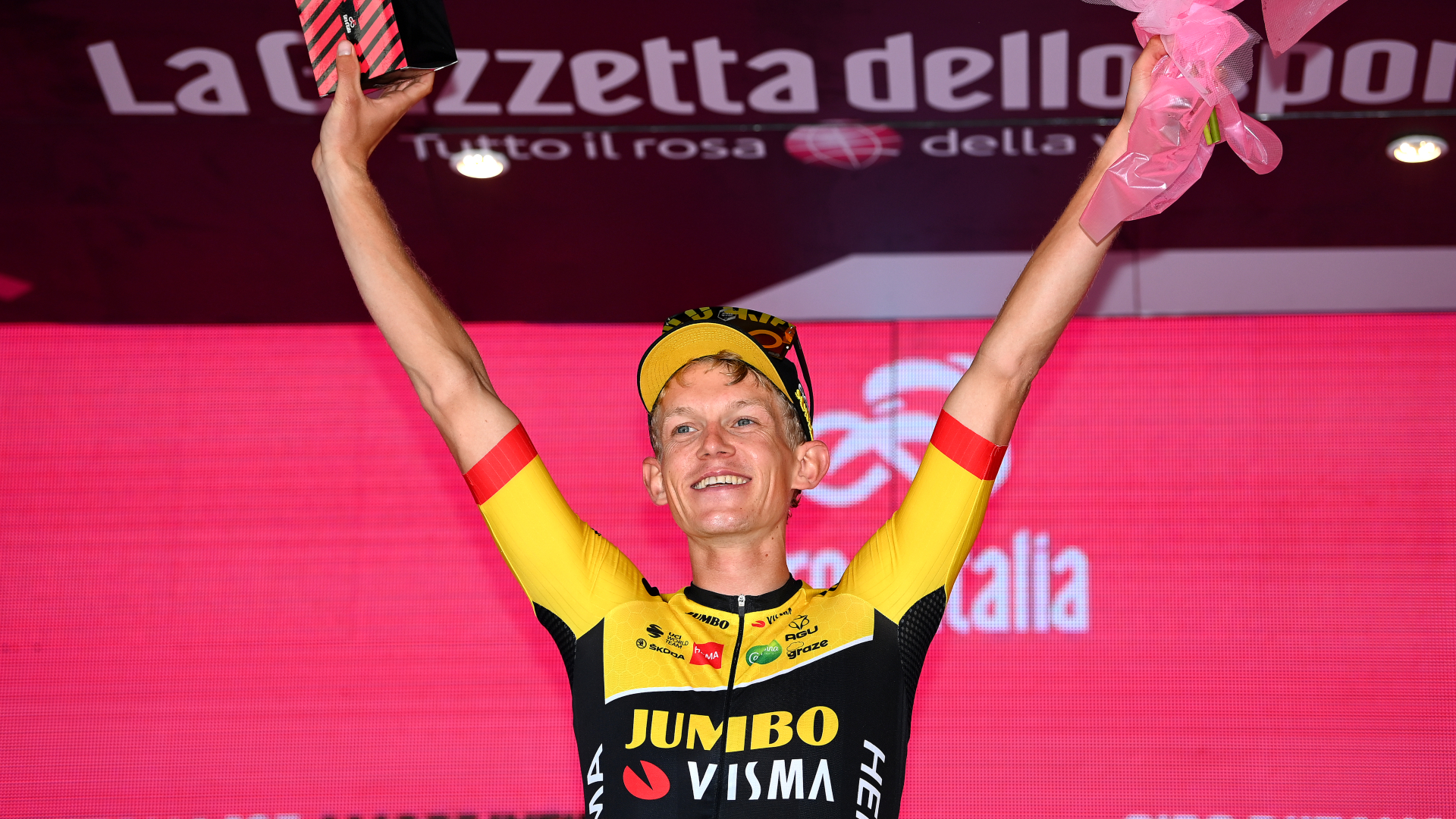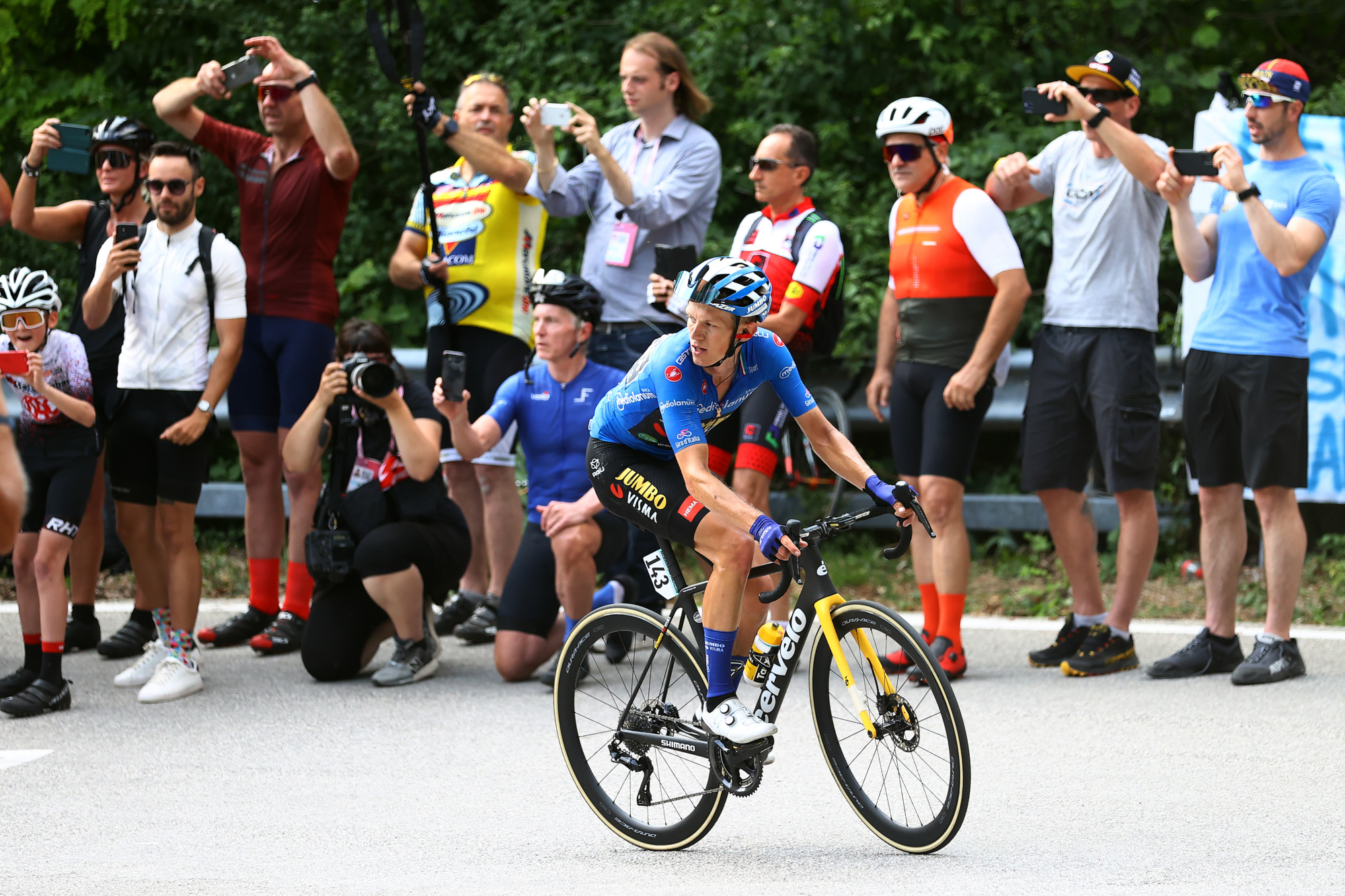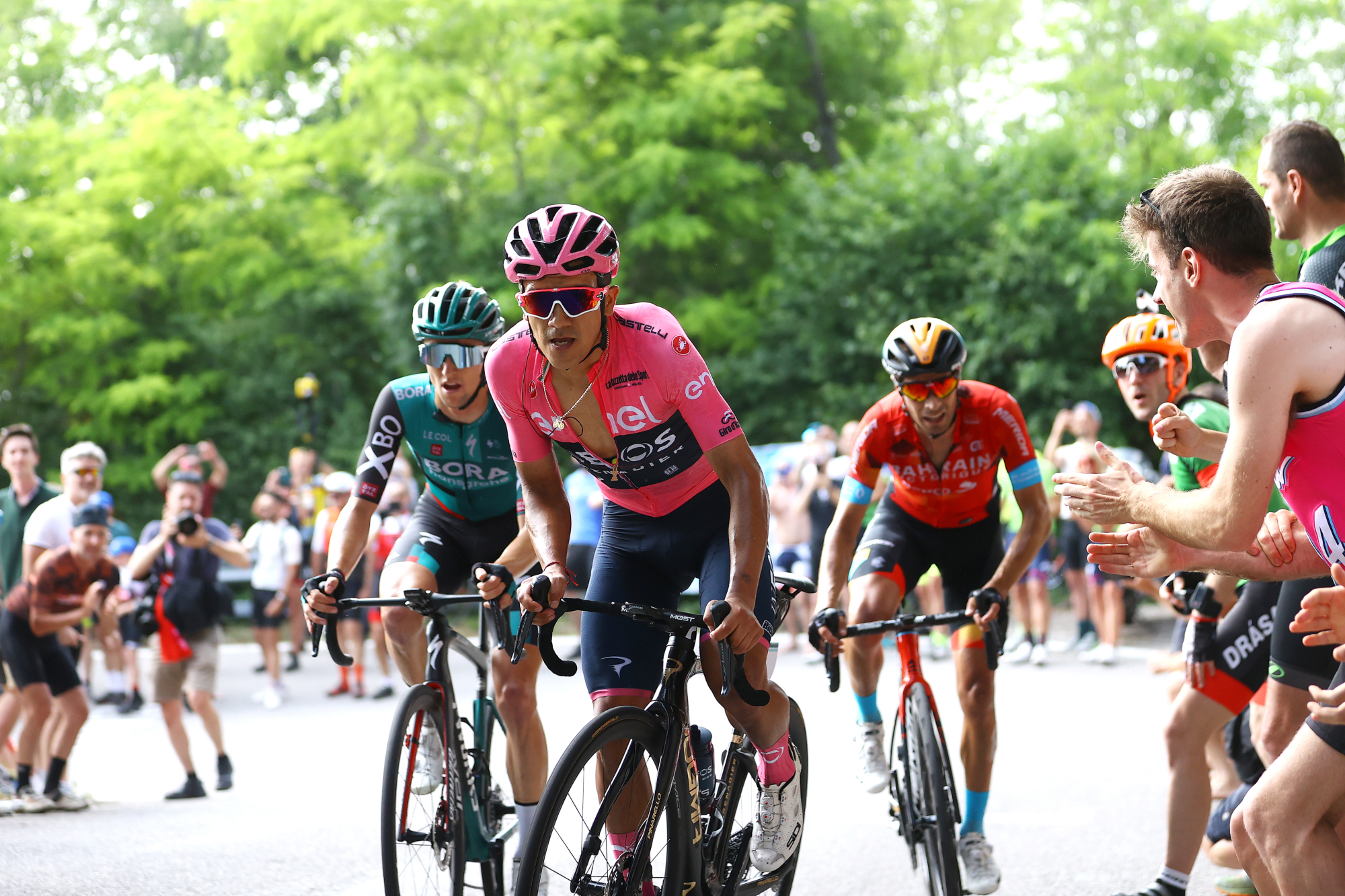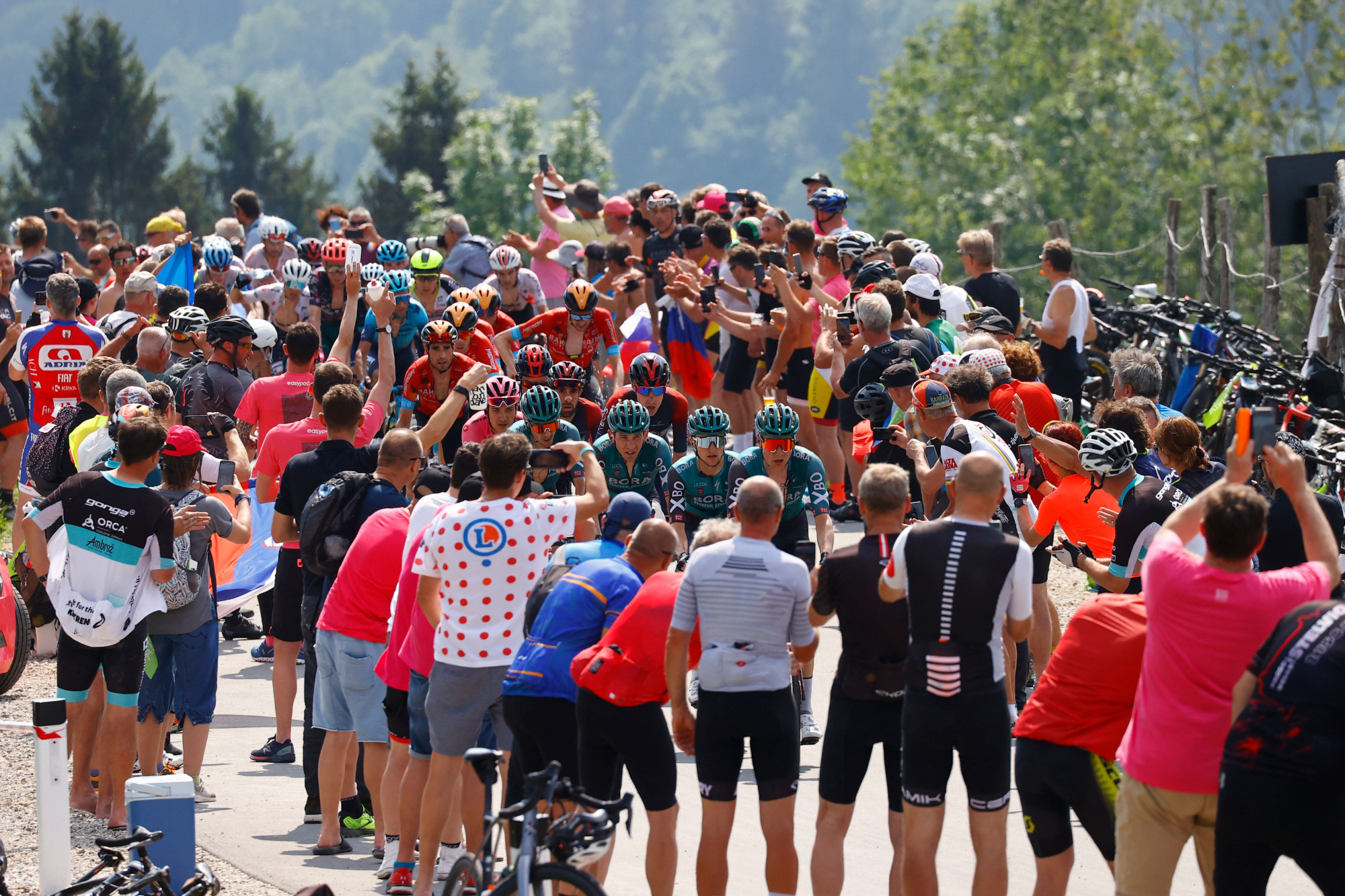Five talking points from stage 19 of the Giro d’Italia 2022
Jumbo-Visma's Koen Bouwman doubles up while Carapaz stays in pink

Bouwman wins his second stage...

Koen Bouwman (Jumbo-Visma) is having quite the Giro d’Italia.
Today’s win was his second of the race, having triumphed on stage seven, when he held off Bauke Mollema (Trek-Segafredo) and Davide Formolo (UAE Team Emirates) over some very lumpy terrain. Only Arnaud Démare (Groupama-FDJ) can boast more wins in this edition of the corsa rosa.
It was the mountains proper on stage 19 of the 2022 Giro d'Italia route, but Bouwman had already proved he had the legs for the steep stuff, with him leading the race for the climbers’ jersey (more on that later) by a considerable margin.
He got away in an original breakaway of 12, which was established after around 25 kilometers of riding and had as much as 12 minutes on the peloton at one point. Due to the flat opening of the stage the composition of the group was rather eclectic, with sprinters, rouleurs, stage hunters and climbers all represented.
However, with almost 3,500 metres of elevation gain, it was unlikely they would stay together, and sure enough the likes of Fernando Gaviria (UAE Team Emirates), Edward Theuns (Trek-Segafredo) and Davide Ballerini (Quick-Step Alpha Vinyl) were dropped. Magnus Cort (EF Education EasyPost) eventually followed suit, no doubt fatigued by his involvement in yesterday's break and by the grueling nature of the race in general. By the time they hit the slopes of the day’s final climb to Santuario Di Castelmonte, the break was down to just five riders.
Both a significant lead over the maglia rosa group and the fluctuating gradients of the climb, allowed Bouwman, Mauro Schmid (Quick-Step Alpha-Vinyl), Alessandro Tonelli (Bardiani-CSF-Faizanè), Attila Valter (Groupama - FDJ) and Andrea Vendrame (AG2R Citroën) to play cat and mouse, sometimes in slow motion. It made for strange viewing at times, this being one of the few summit finishes in the race, where you’d expect riders to be trading blows during the final few kilometers rather than looking to trackstand each other into submission. In the end it came down to a sprint finish, with Bouwman seeing off Schmid and Tonelli, while Vendrame and Valter took care of themselves by way of mistiming the final, rather sharp, corner and ending up tangled in a pink banner that adorned the side of the road.
...he also wraps up the king of the mountains competition

Not only will Bouwman leave this year’s Giro with at least two stage victories to add to his palmares, he’ll also likely be the proud winner of the maglia azzurra.
Get The Leadout Newsletter
The latest race content, interviews, features, reviews and expert buying guides, direct to your inbox!
As long as he remains upright into Verona, he will become the first Dutch cyclist to ever wear the mountains jersey in the Giro d’Italia at the conclusion of the race. In fact the Jumbo-Visma man will be only the fourth Dutch rider in grand tour history to win the best ‘best climbers’ category.
Looking to defend the jersey he got into the day’s breakaway and duly mopped up maximum points on each of the climbs. At the start of the day his lead over Giulio Ciccone (Trek-Segafredo) in second was large. By the end it was insurmountable. He enters tomorrow’s final road stage with 294 points, while Ciccone remains on 103.
Bouwan’s success also means that Jumbo-Visma will leave the Giro satisfied, after their hopes for a podium place crumbled with Tom Dumolin’s early exit. Bouman’s stage win today was the 86th grand tour victory for the Dutch outfit. They’ll no doubt be hoping to increase this total come July. They’ll also be keen to add a yellow jersey to go alongside Bouwman’s little blue number.
The race for pink remains as tight as ever

Ahead of the stage it was difficult to predict if we’d see much Giro GC standings action. While the 167km offered up plenty of climbing, the fierce Kolovrat climb appeared to come too early in the day, while the closing climb didn’t seem quite fierce enough to be a launch pad for any serious attacks. And of course there was also the small matter of tomorrow to consider, a beast of stage that certainly offers plenty of opportunity to make up, or in the case of Richard Carapaz (INEOS Grenadiers), take more time.
In the end the parcours predictions came true. The Kolovrat was indeed too far out for any of the GC protagonists to seriously consider launching an attack, while the Santuario Di Castelmonte wasn’t quite steep enough for anything to stick. Carapaz, Jai Hindley (Bora-Hansgrohe) and Mikel Landa (Bahrain Victorious) all tried a few digs on the final slopes but this wasn’t a ding-dong battle, rather a series of teasing jabs, ahead of tomorrow’s sterner test.
The result of this stalemate is that we’ll head into the penultimate day of the 105th Giro with Carapaz and Hindley still separated by the width of a cigarette paper, or three seconds to be precise.
At this stage in the race it’s the second narrowest margin in giri history. The only time the two leading riders were separated by a shorter margin was in 1996, when after the Marostica time trial, Pavel Tonkov led by just a single second over Abraham Olano, and a further 14 seconds over Evgueni Berzin. The Russian rider would go on to win the maglia rosa.
Richie Porte abandons leaving Carapaz a man down

Richard Carapaz will head into tomorrow’s penultimate stage without the support of his chief gregari Richie Porte (INEOS Grenadiers). The Australian was forced to abandon the race due to stomach problems. After getting distanced on the first climb he soldiered on for several kilometres before eventually climbing off his bike with 80km of the stage remaining.
It’s a cruel way for the 37-year-old to bow out, in this his last ever grand tour. It could prove to be just as disastrous for Carapaz, given tomorrow’s hellish parcours. With close to 5000 metres of climbing, stage 20 will surely be decisive in the battle for the maglia rosa. Teammates, or lack of, could make all the difference.
Certainly, it places greater responsibility on the remaining Ineos riders, who’ll want to try and control the race when the road points up. Porte would have been expected to stick around on the slopes of the Passo Pordoi and the Marmolada, preventing Carapaz from becoming isolated and therefore more susceptible to blows from Jai Hindley and his Bora boys. With Porte gone, it will likely fall to Pavel Sivokov, Jonathon Castroviejo and perhaps Ben Tulett to put out the fires that are bound to be ignited on tomorrow’s steep gradients.
But filling Porte’s shoes won’t be easy, whichever Grenadier is required to do so. A veteran of 17 grand tours, there’s not much he hasn’t seen, instrumental in the Tour de France victories of Bradley Wiggins, Chris Froome and Egan Bernal. A level head, a gritty competitor, a world-class climber, he’ll be missed. Just quite how much remains to be seen.
The Kolovrat impresses on its debut

While iconic climbs are vital for any grand tour, helping to connect past with present, the inclusion of new mountain pass is always exciting. Today there were two climbs which hadn’t featured in previous giri: the Kolovrat and the Santuario Di Castelmonte. And they didn’t disappoint.
The scenery was stunning for much of the day and the slopes of the Kolovrat, located over the border in Slovenia, were the stuff of desktop screensaver heaven. As previously mentioned this time around the 10km climb, which has sections of 15%, came a little early in the stage to impact the GC but its steep gradients and breathtaking views surely mean we will see it used again, hopefully as a summit finish.
Likewise the Santuario Di Castelmonte added to the drama of the stage, thanks to the last hairpin that caught out Vandrame. Even stage winner Bouwman, who’d done his homework by studying the Garibaldi, was taken by surprise. “I knew that the last corner was a hairpin,” he said after the stage, “but I didn’t expect it to be so much.”
Tomorrow sees the race back on more familiar roads with stage 20 hitting the Dolomites and taking in the fabled climbs of the Passo Pordoi, at 2239m this year’s Cima Coppi, and the Passo Fedaia, affectionately known as the Marmolada. It appeared in the corsa rosa for the first time in 1970 and was last used in 2011, with Stefano Garzelli the first rider across the summit. The man who repeats that feat in tomorrow’s stage could well see himself wearing pink come Sunday evening in Verona.

Thank you for reading 20 articles this month* Join now for unlimited access
Enjoy your first month for just £1 / $1 / €1
*Read 5 free articles per month without a subscription

Join now for unlimited access
Try first month for just £1 / $1 / €1
Luke Friend has worked as a writer, editor and copywriter for over twenty five years. Across books, magazines and websites, he's covered a broad range of topics for a range of clients including Major League Baseball, Golf Digest, the National Trust and the NHS. He has an MA in Professional Writing from Falmouth University and is a qualified bicycle mechanic. He has been a cycling enthusiast from an early age, partly due to watching the Tour de France on TV. He's a keen follower of bike racing to this day as well as a regular road and gravel rider.